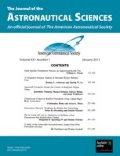Abstract
First-order necessary conditions for optimality reveal the Hamiltonian nature of optimal control problems. Regardless of the overwhelming awareness of this result, the implications that it entails have not been fully explored. We discuss how the symplectic structure of optimal control constrains the flow of sub-volumes in the phase space. Special emphasis is devoted to dynamics in the neighborhood of optimal trajectories and insight is gained into how errors in the initial states affect terminal conditions. Specifically, we prove that if the optimal trajectory does not satisfy a particular condition, then there exists a set of variations in the initial states yielding a greater error in norm when mapped to the terminal time through the state transition matrix. We relate this result to the sensitivity problem in solving indirect problems for optimal control.






Similar content being viewed by others
Notes
For repeatability purposes, the shooting problem is solved by means of the fsolve function of MATLAB using default settings
References
Arnold, V.I.: Mathematical methods of classical mechanics. Springer, New York (1989)
Bryson, A.E., Ho, Y.-C.: Applied optimal control: optimization, estimation and control. CRC Press, Boca Raton (1975)
de Gosson, M., Luef, F.: Symplectic capacities and the geometry of uncertainty: The irruption of symplectic topology in classical and quantum mechanics. Phys. Rep. 484(5), 131–179 (2009)
de Gosson, M.A.: The symplectic camel and the uncertainty principle: The tip of an iceberg? Found. Phys. 39(2), 194–214 (2009)
de Gosson, M.A.: Symplectic methods in harmonic analysis and in mathematical physics. Springer Science + Business Media, Berlin (2011)
Gromov, M.: Pseudo holomorphic curves in symplectic manifolds. Invent. Math. 82(2), 307–347 (1985)
Hsiao, F.-Y., Scheeres, D.J.: Fundamental constraints on uncertainty evolution in hamiltonian systems. IEEE Trans. Autom. Control 52(4), 686–691 (2007)
Maruskin, J.M., Scheeres, D.J., Bloch, A.M.: Dynamics of symplectic subvolumes. SIAM J. Appl. Dyn. Syst. 8(1), 180–201 (2009)
Pontryagin, L.S.: Mathematical theory of optimal processes. Classics of soviet mathematics. Taylor & Francis, Abingdon (1987)
Acknowledgements
This work was partially supported by the Belgian National Fund for Scientific Research (FNRS) and by the Air Force Office of Scientific Research (AFOSR).
Author information
Authors and Affiliations
Corresponding author
Ethics declarations
Conflict of interests
On behalf of all authors, the corresponding author states that there is no conflict of interest.
Additional information
Publisher’s Note
Springer Nature remains neutral with regard to jurisdictional claims in published maps and institutional affiliations.
Rights and permissions
About this article
Cite this article
Dell’Elce, L., Scheeres, D.J. Sensitivity of Optimal Control Problems Arising from their Hamiltonian Structure. J Astronaut Sci 67, 539–551 (2020). https://doi.org/10.1007/s40295-019-00168-1
Published:
Issue Date:
DOI: https://doi.org/10.1007/s40295-019-00168-1



